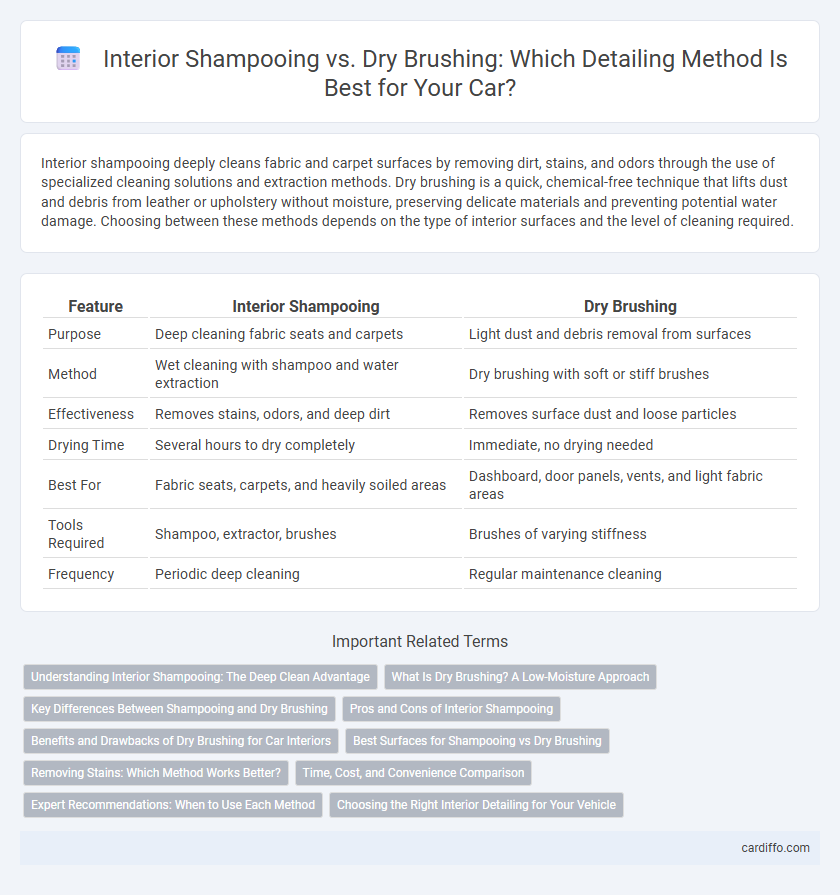Interior shampooing deeply cleans fabric and carpet surfaces by removing dirt, stains, and odors through the use of specialized cleaning solutions and extraction methods. Dry brushing is a quick, chemical-free technique that lifts dust and debris from leather or upholstery without moisture, preserving delicate materials and preventing potential water damage. Choosing between these methods depends on the type of interior surfaces and the level of cleaning required.
Table of Comparison
| Feature | Interior Shampooing | Dry Brushing |
|---|---|---|
| Purpose | Deep cleaning fabric seats and carpets | Light dust and debris removal from surfaces |
| Method | Wet cleaning with shampoo and water extraction | Dry brushing with soft or stiff brushes |
| Effectiveness | Removes stains, odors, and deep dirt | Removes surface dust and loose particles |
| Drying Time | Several hours to dry completely | Immediate, no drying needed |
| Best For | Fabric seats, carpets, and heavily soiled areas | Dashboard, door panels, vents, and light fabric areas |
| Tools Required | Shampoo, extractor, brushes | Brushes of varying stiffness |
| Frequency | Periodic deep cleaning | Regular maintenance cleaning |
Understanding Interior Shampooing: The Deep Clean Advantage
Interior shampooing offers a deep clean advantage by penetrating fabric fibers to remove embedded dirt, stains, and allergens that dry brushing often misses. This method revitalizes upholstery and carpets, restoring their original texture and appearance while eliminating odors and bacteria. Professional interior shampooing enhances cabin air quality and extends the lifespan of vehicle interiors compared to surface-level dry brushing.
What Is Dry Brushing? A Low-Moisture Approach
Dry brushing is a low-moisture interior detailing technique that uses a soft-bristled brush to lift dust, dirt, and debris from upholstery and carpets without saturating surfaces. This method reduces drying time and prevents moisture-related damage while maintaining fabric integrity. Ideal for sensitive materials, dry brushing ensures thorough cleaning by loosening particles for easy vacuum extraction.
Key Differences Between Shampooing and Dry Brushing
Interior shampooing involves applying a liquid cleaning solution to deep-clean fabric surfaces, effectively removing embedded dirt, stains, and odors through moisture and agitation. Dry brushing uses a specialized brush to dislodge surface dust and debris without moisture, making it ideal for delicate materials prone to water damage. Shampooing provides a more thorough cleanse but requires drying time, while dry brushing offers quick maintenance with minimal risk to upholstery fibers.
Pros and Cons of Interior Shampooing
Interior shampooing provides a deep clean by removing embedded dirt, stains, and odors from fabric seats and carpets, enhancing the overall vehicle hygiene and appearance. However, it requires substantial drying time and may risk mold growth if moisture is not thoroughly eliminated. Compared to dry brushing, interior shampooing is more effective at sanitizing but demands more effort and care in managing moisture levels.
Benefits and Drawbacks of Dry Brushing for Car Interiors
Dry brushing in car interiors offers the benefit of quick dirt and dust removal without moisture, preventing potential mold growth and fabric damage. However, it may not effectively eliminate deep stains or embedded grime, limiting its cleaning power compared to wet methods. The technique requires frequent maintenance to avoid scattering dust, which can reduce overall interior cleanliness and air quality.
Best Surfaces for Shampooing vs Dry Brushing
Interior shampooing is best suited for fabric surfaces like cloth seats, carpets, and floor mats where deep cleaning removes embedded dirt and stains. Dry brushing excels on delicate materials such as leather and vinyl, where minimal moisture prevents damage and helps lift surface dust and debris. Choosing the right method enhances surface longevity and maintains the interior's aesthetic appeal.
Removing Stains: Which Method Works Better?
Interior shampooing penetrates fabric fibers with specialized cleaning agents, effectively loosening and extracting deep-set stains, while dry brushing primarily lifts surface dirt without dissolving stubborn spots. Studies show that shampooing removes up to 90% of organic stains like coffee or food residues, making it superior for thorough stain removal in car interiors. Dry brushing is best suited for light maintenance or prepping surfaces before shampooing, but it cannot replace the deep cleaning efficacy of interior shampooing.
Time, Cost, and Convenience Comparison
Interior shampooing requires more time and labor, often taking 1-2 hours per vehicle, and typically costs between $80 and $150 due to the use of cleaning agents and equipment. Dry brushing is faster, usually completed within 30-45 minutes, and more cost-effective, averaging $40 to $70, as it eliminates the need for moisture and drying time. Dry brushing offers greater convenience for quick detailing jobs, while interior shampooing provides a deeper clean at the expense of longer service duration and higher expense.
Expert Recommendations: When to Use Each Method
Interior shampooing is recommended for heavily soiled or stained upholstery, as it effectively removes deep dirt and allergens using water-based cleaning agents. Dry brushing is preferred for delicate fabrics or quick maintenance, minimizing moisture exposure to prevent mold and material damage. Experts suggest choosing interior shampooing for thorough restoration and dry brushing for routine upkeep or lightly soiled interiors.
Choosing the Right Interior Detailing for Your Vehicle
Interior shampooing effectively removes deep-seated dirt, stains, and odors from fabric and carpet surfaces, making it ideal for heavily soiled vehicles or pet owners. Dry brushing offers a quick, water-free method to lift dust and light debris from dashboards, leather, and delicate materials without risking moisture damage. Selecting the right interior detailing technique depends on the material condition and cleaning requirements, balancing thoroughness with care to preserve your vehicle's interior quality.
Interior Shampooing vs Dry Brushing Infographic

 cardiffo.com
cardiffo.com